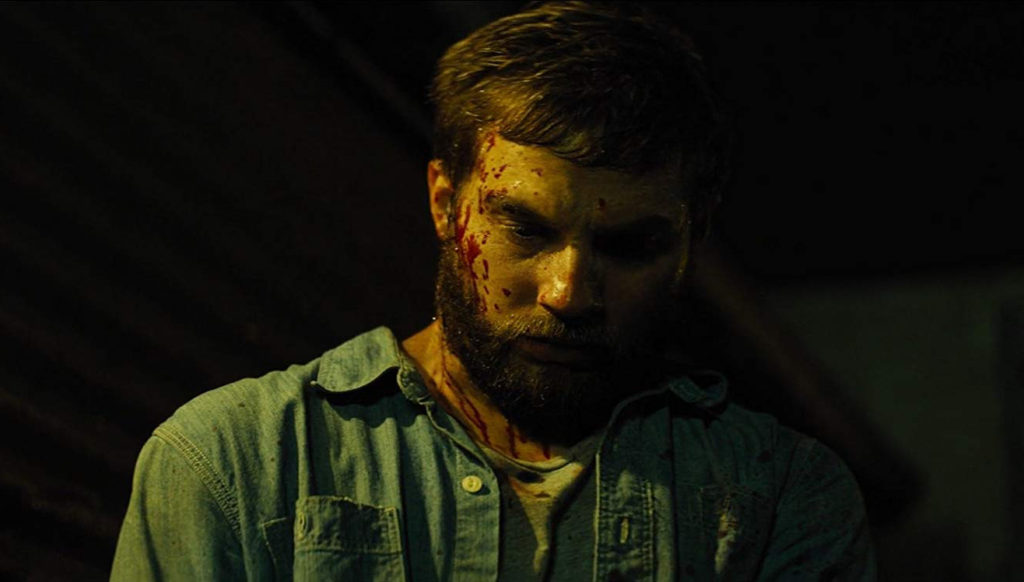Director Leigh Whannell’s “Upgrade” (2018) is a cautionary tale as old as sci-fi itself. This is a gritty take on some well-worn territory but neatly splices together common tropes of the sci-fi and action genres. With stylish execution, these pieces you’ve certainly seen before are fused together into something new.
Hybridisation is not just a part of “Upgrade’s” genre-blending but is also a recurring theme in the film. Futuristic tech is embedded into all surroundings in the world of “Upgrade,” from touch-screen panels on kitchen table tops to A.I. imbued cars and aerial police drones monitoring crime from the skies. A car crash followed by a brutal mugging result in protagonist Grey Trace (Logan Marshall-Green) being left a quadriplegic and witnessing the murder of his wife (Melanie Vallejo). Only by infusing his own body with an A.I. called STEM (Simon Maiden), is he able to overcome his condition and even gain some huge physical perks in the process. He uses his new advancements to seek bloody revenge on those responsible for the death of his wife.
“Upgrade” truly surges to life through its kinetic action sequences, where the whimsical camerawork is a thrill to watch. Logan Marshall-Green does a solid job all-round in portraying Grey and despite having no specific scene-stealing moments, it is in these brawl scenes where he excels. When things turn violent, Grey surrenders control of his body movements to his A.I. ally STEM, who conducts some pretty merciless takedowns on his enemies. Here, Green performs these calculated and surgical attacks through his limbs as STEM, whilst also reacting with sheer horror at these actions as Grey. I didn’t know whether to laugh or recoil, so I did a bit of both.
This is a film knows what it wants, just as well as its protagonist does. I wouldn’t blame you for expecting this type of story to deal with themes like humanity – maybe you’d expect to see Grey coming to terms with what he has become whilst trying to hold on to who he was before his mechanical rebirth. Instead, this story bypasses conventions like this and stays streamlined, with laser focus on the Grey’s grisly mission. There is no time for big questions when there are people to pursue and vendettas to fulfil.
Although, that’s not to say the film doesn’t take a breather or two. In fact, there are actually plenty throughout the 100-minute runtime. It’s just that these slower scenes can be pretty hollow. They don’t do much to serve the characters or story beyond just paving the way for the next action sequence through exposition. This leaves such segments feeling like the bland vegetables you have to finish before you can start dessert. The drop in enjoyability in these slower intervals may have you spending much of the film waiting for the next amazing throwdown. This really shouldn’t be the case in a world that seems this interesting (at least on the surface-level that we are shown).

The simple structure of “Upgrade” is also a double-edged sword. Underserved by this are the characters and the intriguingly dingy world that they inhabit. We understand Grey’s motives but don’t know the character too well by the time the credits roll. Even more underserved are the supporting cast. Betty Gabriel ably plays the steely Detective Cortez, out to pull the plug on Grey’s vengeful crusade, however the character is given little more than the role of the textbook ‘good cop.’ Likewise, reclusive young innovator Eron Keen (Harrison Gilbertson) is the Dr. Frankenstein behind Grey’s monstrous augmentation. Yet, despite having unclear motives that allude to there being much more to the character than we’re first shown, Keen is reduced to an exposition dispenser by the climax.
It is definitely interesting to see a grittier take on a futuristic world that is a lot bleaker than what we’re used to. Beyond the shiny skyscrapers is a seedier underbelly with a dark and eerie atmosphere. Unfortunately, not much is done to teach us anything about this world. Besides the fact that Eron Keen’s company “Vessel Computers” has played a big role in the tech advancements, much of the surrounding backstory is left to our imagination. Though this world isn’t quite fully fleshed out, it is the grim mood created that gives it a stamp of identity. This is all anchored by a tense original score composed by Jed Palmer that does a great job capturing the unnerving feel of this world. The final track of this score (titled “A Better Place”) from the film’s conclusion is the standout, with or without the memorable final scene that accompanies it.
While the eye-popping action is the main attraction here, the serviceable yet shallow other components may not be enough to make this a must-watch. However, this high-octane manhunt is a good time and a fun popcorn flick.